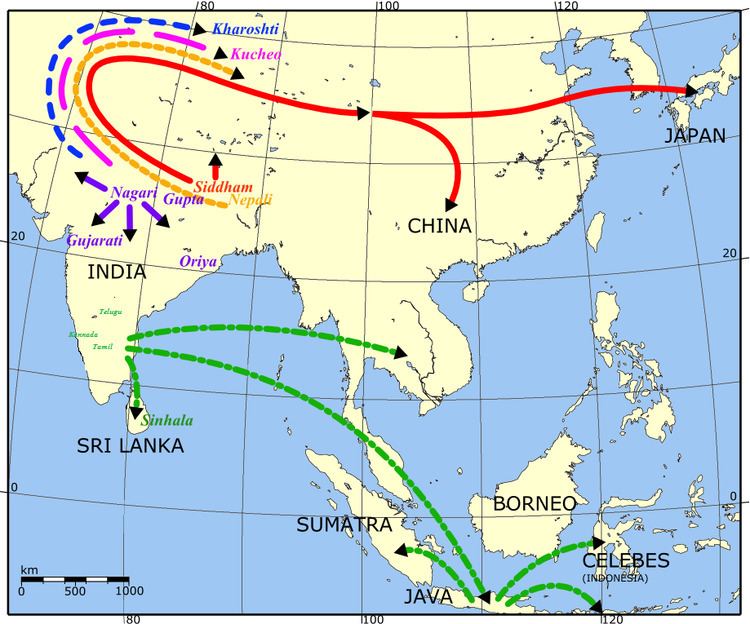 | ||
The Brahmic scripts are a family of abugida or alphabet writing systems. They are used throughout the Indian Subcontinent, Southeast Asia and parts of East Asia, and were once used in Japan, and are descended from the Brahmi script of ancient India. They are used by languages of several language families: Indo-European, Dravidian, Tibeto-Burman, Mongolic, Austroasiatic, Austronesian, Turkic, Tai. They were also the source of the dictionary order of Japanese kana.
Contents
History
Brahmic scripts descended from the Brahmi script. Brahmi is clearly attested from the 3rd century BC during the reign of Ashoka, who used the script for imperial edicts, but there are some claims of earlier epigraphy found on pottery in South India and Sri Lanka. The most reliable of these were short Brahmi inscriptions dated to the 4th century BC and published by Coningham et al., but scattered press reports have claimed both dates as early as the 6th century BC and that the characters are identifiably Tamil Brahmi, though these latter claims do not appear to have been published academically. Northern Brahmi gave rise to the Gupta script during the Gupta period, which in turn diversified into a number of cursives during the Middle Ages, including Siddham, Sharada and Nagari.
The Siddhaṃ script was especially important in Buddhism, as many sutras were written in it. The art of Siddham calligraphy survives today in Japan. The syllabic nature and dictionary order of the modern kana system of Japanese writing is believed to be descended from the Indic scripts, most likely through the spread of Buddhism.
Southern Brahmi evolved into Old-Kannada, Pallava and Vatteluttu scripts, which in turn diversified into other scripts of South India and Southeast Asia.
Bhattiprolu was a great centre of Buddhism during 3rd century BCE and from where Buddhism spread to east Asia. The present Telugu script is derived from Bhattiprolu Script or 'Kannada-Telugu script' or Kadamba script, also known as 'old Telugu script', owing to its similarity to the same.
Initially, minor changes were made which is now called Tamil Brahmi which has far fewer letters than some of the other Indic scripts as it has no separate aspirated or voiced consonants.
Characteristics
Some characteristics, which are present in most but not all the scripts, are:
Comparison
Below are comparison charts of several of the major Indic scripts, organised on the principle that glyphs in the same column all derive from the same Brahmi glyph. Accordingly:
The transliteration is indicated in ISO 15919.
Consonants
Vowels
Vowels are presented in their independent form on the left of each column, and in their corresponding dependent form (vowel sign) combined with the consonant k on the right. A glyph for ka is an independent consonant letter itself without any vowel sign, where the vowel a is inherent. When used to write their own languages, Khmer can have either an a or an o as the inherent vowel, following the rules of its orthography. Thai and Lao script do not have independent vowel forms, for syllables starting with a vowel sound, a "zero" consonant, อ and ອ, respectively, to represent the glottal stop /ʔ/.
Note: Glyphs for r̥̄, l̥, l̥̄ and a few other glyphs are obsolete or very rarely used.
List of Brahmic scripts
Scripts derived from Brahmi.
Historical
The Brahmi script was already divided into regional variants at the time of the earliest surviving epigraphy around the 3rd century BC. Cursives of the Brahmi script began to diversify further from around the 5th century AD and continued to give rise to new scripts throughout the Middle Ages. The main division in antiquity was between northern and southern Brahmi. In the northern group, the Gupta script was very influential, and in the southern group the Vatteluttu and Old-Kannada/Pallava scripts with the spread of Buddhism sent Brahmic scripts throughout Southeast Asia.
Northern Brahmic
Southern Brahmic
(Tamil Brahmi, perhaps 5th or older but certainly 3rd, century BC, Kalinga, Bhattiprolu)
Unicode
As of Unicode version 9.0, the following Brahmic scripts have been encoded:
